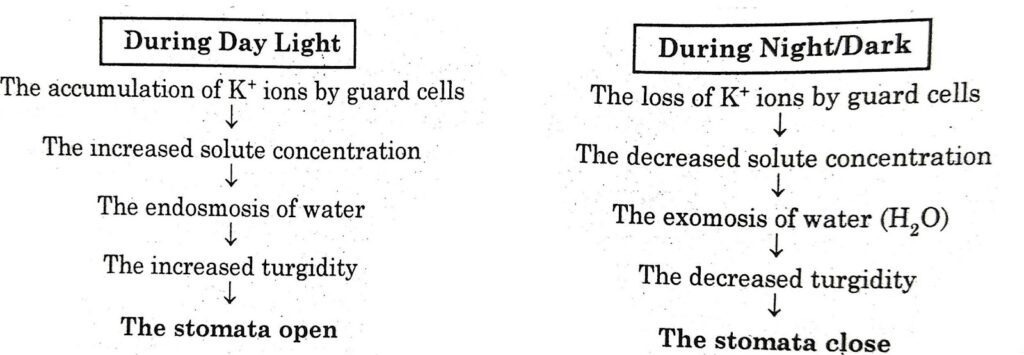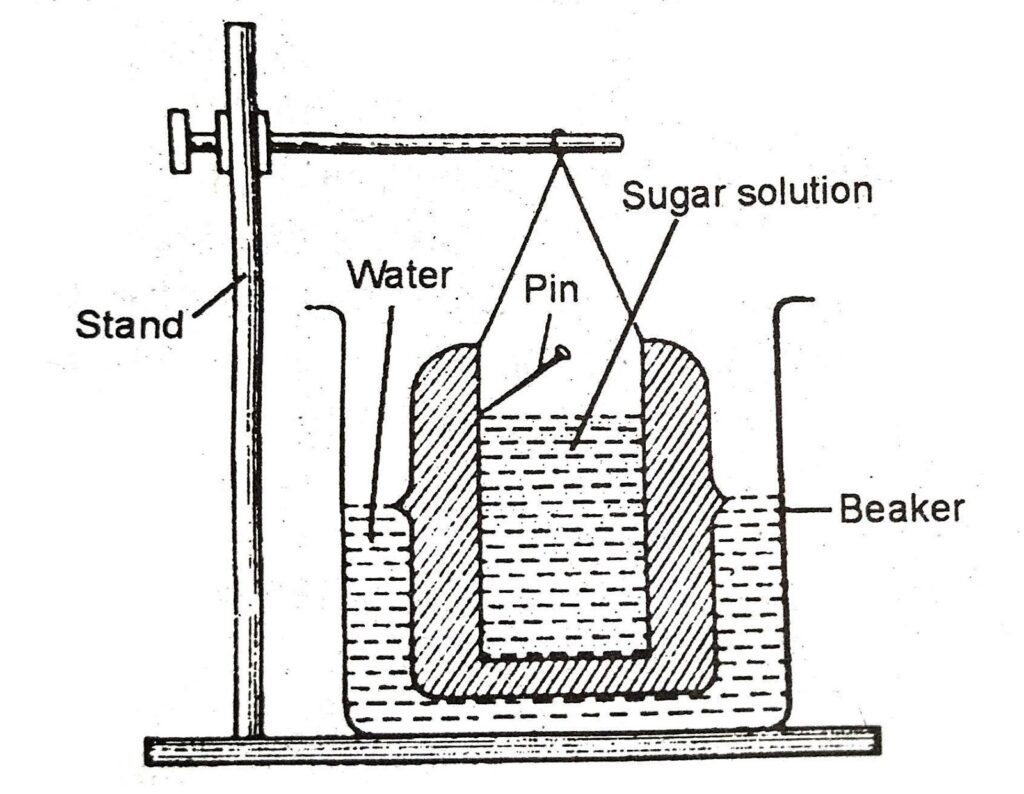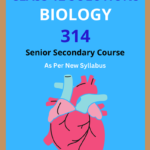NIOS Class 12 Biology Chapter 8 Absorption, Transport and Water Loss (Transpiration) in Plants Solutions to each chapter is provided in the list so that you can easily browse throughout different chapters NIOS Class 12 Biology Chapter 8 Absorption, Transport and Water Loss (Transpiration) in Plants Notes and select need one. NIOS Class 12 Biology Chapter 8 Absorption, Transport and Water Loss (Transpiration) in Plants Question Answers Download PDF. NIOS Study Material of Class 12 Biology Notes Paper 314.
NIOS Class 12 Biology Chapter 8 Absorption, Transport and Water Loss (Transpiration) in Plants
Also, you can read the NIOS book online in these sections Solutions by Expert Teachers as per National Institute of Open Schooling (NIOS) Book guidelines. These solutions are part of NIOS All Subject Solutions. Here we have given NIOS Class 12 Biology Chapter 8 Absorption, Transport and Water Loss (Transpiration) in Plants Solutions, NIOS Senior Secondary Course Biology Solutions for All Chapter, You can practice these here.
Absorption, Transport and Water Loss (Transpiration) in Plants
Chapter: 8
MODULE – II: FORM AND FUNCTION OF PLANTS AND ANIMALS
NIOS TEXTBOOK QUESTIONS ANSWERS
INTEXT QUESTIONS 8.1
1. Define diffusion.
Ans. The diffusion is defined as “the movement of molecules from their region of higher concentration to a region of lower concentration”.
2. Give one point of difference between osmosis and diffusion.
Ans. A semipermeable membrane is needed for osmosis and not needed for the process of diffusion.
3. Name the process because of which crystals of KMnO4 added to water makes it purple.
Ans. This is called the “Diffusion”.
4. If blood cells are placed in salt water, what will happen to them? Based on your answer state if salt solution is isotonic, hypotonic or hypertonic?
Ans. The water will move out from blood cells and they will shrink.
5. When does plasmolysis occur in plant cells?
Ans. When a plant cell is kept in a hypertonic solution.
6. Name the phenomenon which makes at difficult to close a wooden door after monsoon.
Ans. It is called inhibition.
INTEXT QUESTIONS 8.2
1. Which part of the plant absorbs water and minerals?
Ans. The root.
2. What are plasmodesmata?
Ans. There are cytoplasmic connections between the plant cells.
3. How does translocation occur in plants?
Ans. It occurs through the phloem.
4. What is the process of ascent of sap?
Ans. Ascent of sap is “the movement of water and minerals from roots to leaves, i.e. from the ground to tip of a plant.”
5. Which are three different forms in which water is present in the soil?
Ans. (i) Gravitational.
(ii) Hygroscopic, and
(iii) Capillary water are once different forms of waters present in the soil.
INTEXT QUESTIONS 8.3
1. Name the pressure in guard cells responsible for opening and closing of stomata.
Ans. Turgor pressure.
2. Mention the shape of stomata in monocots and dicot.
Ans. (i) Monocot plants: Dumb bell shaped.
(ii) Dicot plant: Kidney shaped.
3. Give a point of difference between a Stoma and a Hydathode.
Ans. Difference between a stoma and a hydathode:
| A Stoma | A Hydathode |
| 1. It is a pore on the surface of leaves through which water evaporates in vapour form. | It is a special pores or water stoma in leaf margins through which water is lost as water droplets. |
TERMINAL EXERCISES
1. Name two types of passive absorption in plants.
Ans. (i) Diffusion.
(ii) Osmosis.
2. In what ways diffusion is important to a plant?
Ans. By diffusion, the gases are exchanged in plants through stomata.
3. Name various factors that affect osmosis in plants.
Ans. (i) Pressure gradient.
(ii) Concentration gradient.
(iii) Solute potential.
(iv) Water potential.
4. Differentiate between Turgor Pressure and Wall Pressure.
Ans. Difference between Turgor Pressure and Wall Pressure:
| Turgor Pressure | Wall Pressure |
| 1. The pressure which develops in a confined part of an osmotic system due to the osmotic entry of water into it, i.e., the pressure exerted by the protoplast of a cell on its cell wall in a turgid condition. | The pressure exerted by the cell wall over the protoplast with an equal and opposite force, i.e. called wall pressure. |
| 2. It is designated as IP. | It is designated as WP. |
5. Discuss the mechanism of stomatal action in dicot plants.
Ans. Effect of potassium ions (K⁺) on the stomata: This has been proved that accumulation of K ion brings opening of stomata but loss of K⁺ ions, closing of stomata.

Uptake of K⁺ ions is balanced by any one of following as explained here.
(i) Uptake of chloride (Cl⁻) ions as anions. These cells lack chloroplast and take up Cl⁻ ions as anions to balance the influx of K⁺ ions.
(ii) Transport of H⁺ ions released from the organic acids. In certain plants guard cells have starch, so there in accumulation of organic acid such as malate, by conversion of starch into malic acid in the light. Organic acid dissociates into malate and H⁺ the Potassium reacts with malate to form potassium malate increases that solute concentration.
(iii) Entry of K⁺ is balanced by the exit of protons (H⁺).
6. Explain any four factors that affect transpiration in plants.
Ans. Different environment factors such as temperature, light, wind, humidity and internal factors like structure of leaf and root-shoot ratio affect the transpiration process in the plants.
Various environmental factors contribute to the occurrence of transpiration and control stomatal movements. Transpiration is affected by wind speed, temperature, humidity, number and % stomata, etc. A very high wind speed or the dry breeze increases the state of transpiration in plants. Canopy structure influences the transpiration.
7. Describe an experiment to demonstrate osmosis by potato osmometer.
Ans. Osmosis: It is “the diffusion of water molecules from a region of high concentration to the region of low concentration.” The water molecules move through the semipermeable membrane.
Demonstration of Osmosis: Take a big potato and peel of its outer skin and cut its one end to make its base flat. Now make a hole and cavity in potato almost up to flat base.
Keep some sugar solution into it and make level by a pin. Put it in a beaker having H₂O and permit the apparatus to stand for along 30 minutes time. The level of solution in potato cavity rises. The water from beaker enters into tuber by this layer of cells (differentially permeable membrane). So it exhibits osmosis.

Fig. 8.7. Experiment to demonstrate osmosis by means of potato osmoscope.
8. Discuss the cohesion tension theory for uptake of water in plants.
Ans. Cohesion Tension Theory for uptake of H₂O in the Plants: Water moves up to xylem vessels to leaf along water potential gradient. It is explained by the cohesion-tension theory. It is most acceptable theory. The transpiration (evaporation of water) from the plant through stomata, causes a pull and water moves up like a water column because of the force of cohesion and tension produced by the process of transpiration in plants.
9. Describe the mechanism of translocation of solutes. Name the most appropriate theory for the translocation of solutes in plants. Who proposed this theory?
Ans. Translocation of solutes: It is defined as “the movement of prepared food from one organ of a plant to another organ is called translocation of solutes.”
Mechanism of Translocation of Solutes: The girdling experiment shows that girdled tissue (phloem) is concerned with downward translocation. In girdled plants parts below the girdle become starved. Such plants would not survive for long.
The Chemical analysis of phloem and xylem sap: It shows that “phloem sap is relatively rich in carbohydrates and other organic compounds (the concentration of organic compounds is more during the day time when photosynthesis takes place).”
Structure of Phloem: The sieve tubes, is well suited for longitudinal translocation. They are elongated cells arranged end to end and have sieve plates on end walls. The companion cells associated with the sieve tubes help in phloem loading (transfer of prepared food from chlorophyllous cells to phloem). Thick walled phloem (fibres give mechanical support to phloem.
Direction of Translocation: Translocation occurs in all the directions in the plant. The organic food material is translocated in downward direction to the root for its own need and for storage. During the period of active growth when new shoots, flowers and fruits are formed, food material is translocated from roots to the stem, i.e., in upward direction.
Mechanism of Translocation: Various theories have been proposed to explain mechanism of translocation of solutes in higher plants.
They are:
(A) Protoplasmic Streaming (Cyclosis): Hugo de Vries (1885) proposed “the streaming of protoplasm (also called cyclosis) might be the mechanism of solute translocation.” Streaming involves circulation of protoplasm along the periphery of a sieve element. The streaming of protoplasm depends upon the contraction of elongated protein molecules and utilises ATP. As the cytoplasm rotates, solute molecules are transported from one end of the sieve tube to another. Transfer of solute from one sieve tube to another takes place by diffusion. The theory place by diffusion. The theory was supported by many workers as it can explain simultaneous upward and downward translocation.
(B) Contractile Proteins: It was proposed by the Fensom (1974). Who observed “a network of interlinked microfibrils in the lumen of the sieve tubes. These fibrils were made up of contractile threads of p-protein).”
(C) Mass Flow (Pressure Flow) Hypothesis: It is the most widely accepted theory of translocation of solutes. It was given by Ernst Munch in 1928. It is also called the mass flow, solution flow or pressure flow theory. It explain that glucose prepared by photosynthesis is converted into sucrose, sucrose is moved in companion cells of phloem; then into sieve tube cells by active transport.
(D) Electro-osmosis Hypothesis: It was proposed by Fensom (1957) and Spanner (1958). According to it “solute moves in the positive tion of electrical gradient along with K⁺ ions.”

Fig. 8.8. Mass Flow theory.
10. Differentiate between symplast and apoplast pathway of water movement in plants.
Ans. Difference between Apoplast and Symplast pathways of Movement of Water in Plants:
| Apoplast movement | Symplast movement |
| 1. Water is drawn from the soil through inter-veining apoplast along the gradient. | In symplast movement of water, plasmodesmata are involved. |
| 2. Takes place through cell wall exclusively without crossing any membrane. | Water moves from one cell to another through symplast, the living component. |
11. Define transpiration.
Ans. The process of loss of water as vapours through the aerial parts of a plant through stomata is termed as transpiration.
12. Name the holes in the bark through which transpiration in the bark of old trees takes place.
Ans. Lenticels. (See Fig. 8.9)

Fig. 8.9. T.S. of Lenticel.
13. Why is transpiration considered to be a necessary evil?
Ans. Transpiration in higher plants is considered a necessary evil because major portion of the water absorbed by plants is evaporated into atmosphere from the aerial part of plants through this process. Only a small amount of water absorbed is actually used by plants to perform various biological activities. But we cannot stop this evil. Because of this evil, various biological activities are possible only in the presence of water. However, these days to reduce the role of transpiration, various anti-transpirations are used.
14. Give one way by which desert plants prevent transpiration.
Ans. The desert plants prevent transpiration/ water loss by having reduced number of stomata on the upper surface or stomata may be smokin into the pits. The leaves have thick cuticle or the leaf surface in waxy.
15. Distinguish between transpiration and guttation.
Ans. Differences between the Guttation and Transpiration:
| Guttation | Transpiration |
| 1. It is the loss of water in liquid form. | It is loss of water in the form of water vapours. |
| 2. It occurs through hydathodes. | stomata, cuticle or lenticels. |

Hi! my Name is Parimal Roy. I have completed my Bachelor’s degree in Philosophy (B.A.) from Silapathar General College. Currently, I am working as an HR Manager at Dev Library. It is a website that provides study materials for students from Class 3 to 12, including SCERT and NCERT notes. It also offers resources for BA, B.Com, B.Sc, and Computer Science, along with postgraduate notes. Besides study materials, the website has novels, eBooks, health and finance articles, biographies, quotes, and more.




